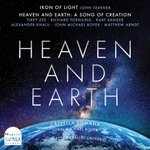|
Back
12/22/2022
“Heaven and Earth”
John Tavener: Ikon of Light
Matthew Arndt, John Michael Boyer, Alexander Khalil, Kurt Sander, Richard Toensing, Tikey Zes: Heaven and Earth: A Song of Creation
Ron Blessinger (violin), Greg Ewer (viola), Marilyn de Oliveira (cello), 45th Parallel Universe, John Michael Boyer (conductor), Cappella Romana, Alexander Lingas (music director and founder)
Recording: St. Stephen Catholic Church, Portland, Oregon (July 19‑22, 2021) [World Premiere Recording] – 87’47
SACD Cappella Records CR424 – Booklet in English and Greek

   
Long overlooked as a part of the classical tradition, Christian Orthodox music has gained the attention of Western listeners and scholars in recent decades. The music of British composer John Tavener and the Estonian master, Arvo Pärt, has opened doors to a form of self-expression and worship rich in harmonic innovation, meaningful ornamentation and architectural originality.
In 2021, Benedict Sheehan’s Liturgy of Saint John Chrysostom (reviewed here on October 20, 2020) was nominated for a Grammy © for Best Choral Performance. Now, Cappella Romana, a professional vocal ensemble and one of the leading recorders of both ancient and contemporary Orthodox music, has released “Heaven and Earth.” The first of two CDs is devoted to Tavener’s Ikon of Light, composed in 1984 on a commission from the Tallis Scholars. The second CD is devoted to Heaven and Earth: A Song of Creation, a cycle of nine sacred songs based largely on verses from Psalm 103, composed cooperatively by six composers who are influenced by the Orthodox tradition. The album provides a selection of music which is contemporary and fresh, but firmly rooted in a faith tradition shared by some 300‑million people worldwide.
Under the direction of John Michael Boyer, Cappella Romana is joined by a string trio drawn from a musicians’ collective, 45th Parallel Universe. The group’s geographical title comes from the latitudes which lie halfway between the equator and the poles, offering cross‑sections of the world’s diverse cultures.
That being said, there is something otherworldly about these recordings, which include Tavener’s nearly 40‑year-old Ikon, and the 21st century Heaven and Earth in nine movements. In this edition and performance, the Tavener work lifts up and offers, as though it were encased in a chalice, the Mystic Prayer to the Holy Spirit of St. Simeon the New Theologian (949 to 1022). The ancient prayer is a series of invitations to the listener in the intimate second‑person singular, beginning with a Greek word for “come,” namely, elthé. For example, “Come true light. Come life eternal. Come hidden mystery.”
Technically, the prayer is confined to Track 4. But the build‑up in the three movements before, and the recession of the three after, creates a kind of mandala in sound. “Mandala” has been defined as a visual map of the human spirit, and so is this seven‑movement prayer, with its long entrance, amazing centerpiece, and gradual withdrawal, a map of the soul in music. St. Simeon is considered the first Eastern Christian to speak and teach publicly about his mystical experiences, using the language of illumination and light. All this may be very “out there” to a music lover who simply wants to enjoy familiar harmonies or learn about the latest musical trends. Yet it is impossible to separate Tavener’s music in this performance from the context of spirituality. In every measure, we are confronted by an integration of faith and art not unlike our experience of Messiaen and J.S. Bach. By the conclusion of this first CD, I had gained a new respect for Tavener. He was an artist in need of a particularly understanding ensemble to express his vision. He found this ensemble, posthumously, in Cappella Romana.
Turning to the second work, Heaven and Earth, it is important to remember that this album features composers who are influenced by Orthodox traditions and does not reflect the original source material itself, though some is cited throughout. The distinctive elements of Orthodox music—the sudden flats, modal transpositions, un‑Western turns and shakes—are used by each composer as elements in a paint box, selected to shed light on the text and to create a unique musical palette. The overall sound of this album is one of strength and power. The texts of creation (translated into English) unfold as though accompanying a cosmic explosion which unifies science and belief. This is bold music with nothing weak or tentative. I was heartened by the strong presence of women’s voices in these renditions. The overall impact of choir and string trio, regardless of which composer is featured, remains one of energetic engagement and self-confidence.
While both works made a positive impression on first and second hearings, I am still curious as to how the composition of the Heaven and Earth segments came about, how the various sections depicting the creation were assigned or contributed, and how they were woven together to create an appealing musical tapestry. The work has an impressive symmetry and unity considering the number of creators involved in its composition.
Together with Ikon, the Heaven and Earth section of this album provides a balanced program of music that is totally modern but bearing an indisputable imprint of Eastern Christian traditions. This balance and revelation is Cappella Romana’s unique gift to world music, a door opening to greater understanding and the expansion of our appreciation of beauty.
Linda Holt
|